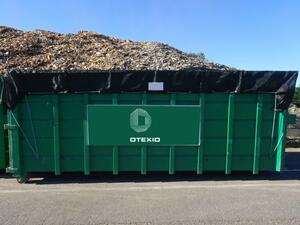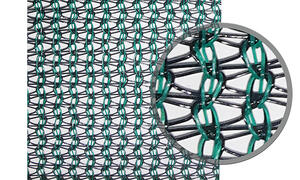All our tips for choosing a dumpster net
As a specialist in tarping systems, nets, and industrial protective solutions for transportation and the environment, OTEXIO is here to assist you in selecting the right type of container net tailored to your transport bin's size, budget, site constraints, loading frequency, and the materials being transported.

Standard square mesh nets with 25mm or 50mm mesh sizes are made from UV-stabilized polyethylene. Small-mesh or millimeter-sized mesh nets, of which OTEXIO was one of the first distributors, have since emerged alongside traditional mesh nets. More effective against wind on light materials, these nets do not catch on material irregularities and slide more easily during installation and removal. They are particularly useful for protecting green waste in agricultural containers or landscapers' vehicles.
Container nets now come in a wide range of mesh sizes and materials to offer tailored protection to professionals.
Coated micromesh nets consist of a core of PVC-coated polyester filaments and are UV-treated. They are used on waste bins and voluntary drop-off points for their durability and their quality as windbreaks and shading solutions.
Knitted micromesh nets are favored for their affordability and ease of use.
Woven micromesh nets are used for transporting metals or straw due to their tear resistance.

Our range includes frame nets for containers and semi-trailers, nets with extended lengths for semi-flatcontainer and moving floor trucks, and aftermarket nets for automatic tarp systems.
Our made-to-order net fabrication service for mud bins, compactors, and waste containers ensures a protection system tailored to your usage and attachment system.
Our technicians are present throughout France to help you find the right container net size for your needs or to offer custom fabrication.
Take a look at our customized nets.
The contents of the bin must be considered when choosing the net that offers the best protection and ease of use.
Our standard nets for landscaper trucks and other containers come in 25mm mesh for transporting green waste or paper, and 50mm mesh for cardboard, wood, and pallets.
For transporting sensitive load such as industrial waste, choose a protective net for construction trucks that is UV-treated and resistant, like the coated micromesh protective net, which is used as a moving floor frame net or as a standard net for bins based on its weight and tear resistance.
Container nets have benefits for both the agricultural and construction sectors: an ideal alternative to tarps when waterproofing is unnecessary, they come in various mesh types depending on the transported materials. Trust OTEXIO's experts to analyze your needs and advise you on the most suitable container net dimensions and type. Note: The text you provided contains some formatting and emcontainerded content related to translation tools that cannot be directly translated. I've focused on the main content and translated it accordingly.

Understanding container nets and their utility
According to the law, all transported goods and materials must be covered to limit the risks of losses (which can be hazardous for the environment and road users) and to effectively shield sensitive materials from heat or moisture. Tarps are used to ensure waterproofing. When rain protection isn't necessary, a net is sufficient: lighter than a tarp, a container net simplifies the tarping and untarping process during loading and unloading.Standard square mesh nets with 25mm or 50mm mesh sizes are made from UV-stabilized polyethylene. Small-mesh or millimeter-sized mesh nets, of which OTEXIO was one of the first distributors, have since emerged alongside traditional mesh nets. More effective against wind on light materials, these nets do not catch on material irregularities and slide more easily during installation and removal. They are particularly useful for protecting green waste in agricultural containers or landscapers' vehicles.
Container nets now come in a wide range of mesh sizes and materials to offer tailored protection to professionals.
Coated micromesh nets consist of a core of PVC-coated polyester filaments and are UV-treated. They are used on waste bins and voluntary drop-off points for their durability and their quality as windbreaks and shading solutions.
Knitted micromesh nets are favored for their affordability and ease of use.
Woven micromesh nets are used for transporting metals or straw due to their tear resistance.

Selecting a container net based on bin size
To ensure that the container net fulfills its function of triple protection for transported materials, road users, and the environment, it's important to choose a net size and type that suits your bin and vehicle. OTEXIO offers nets designed for bins ranging from 4m³ to 45m³, as well as the option to manufacture custom-sized nets for your truck, van, or trailer.Our range includes frame nets for containers and semi-trailers, nets with extended lengths for semi-flatcontainer and moving floor trucks, and aftermarket nets for automatic tarp systems.
Our made-to-order net fabrication service for mud bins, compactors, and waste containers ensures a protection system tailored to your usage and attachment system.
Our technicians are present throughout France to help you find the right container net size for your needs or to offer custom fabrication.
Take a look at our customized nets.
Selecting a container net based on transport type
The type of bin transport (on the road, by rail freight, or in maritime containers) implies a specific net selection: does the net aim to protect the bin during storage or also during transport? Bins operating on roads must be effectively shielded against the risks of material scattering.The contents of the bin must be considered when choosing the net that offers the best protection and ease of use.
Our standard nets for landscaper trucks and other containers come in 25mm mesh for transporting green waste or paper, and 50mm mesh for cardboard, wood, and pallets.
For transporting sensitive load such as industrial waste, choose a protective net for construction trucks that is UV-treated and resistant, like the coated micromesh protective net, which is used as a moving floor frame net or as a standard net for bins based on its weight and tear resistance.
Container nets have benefits for both the agricultural and construction sectors: an ideal alternative to tarps when waterproofing is unnecessary, they come in various mesh types depending on the transported materials. Trust OTEXIO's experts to analyze your needs and advise you on the most suitable container net dimensions and type. Note: The text you provided contains some formatting and emcontainerded content related to translation tools that cannot be directly translated. I've focused on the main content and translated it accordingly.